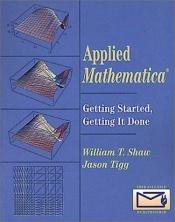Applied Mathematica: Getting Started, Getting it Done
Resumen
As an applied scientist you are constantly looking for new and better ways to solve problems. This book shows how Mathematica, the powerful mathematical software system, can be used to solve problems in the applied sciences.Written by two authors who have been teaching Mathematica courses to scientists and engineers for years, this book is a must for anyone who needs to use Mathematica to solve complex problems in the applied sciences. The book tackles complex, practical problems, and shows how to solve them from start to finish.
After presenting a "quick start" chapter designed to get you using Mathematica quickly, the authors show how Mathematica can be used as a data analysis and visualization system. Topics in this section include importing information to Mathematica, organizing information, visualizing data in both 2D and 3D, processing information, and exporting results from Mathematica. Next, the authors guide you through programming in Mathematica. Included here are topics such as programming styles, important built-in structures, function definitions, procedural methods, rule-based schemes and iteration, contexts and packages, and increasing efficiency. Also included is a separate section detailing several case studies that explore and apply Mathematica to particular areas. These areas include engineering, finance, environmental modeling, and image processing. The case studies span a wide range of applications - from serious data analysis using robust regression theory and maximum entropy theory, to an enjoyable exploration of the Mandelbrot set using MathLink to create a movie. The book also includes eight pages of full-color images.

 Español
Español English
English Deutsch
Deutsch










Reseñas de los usuarias/os Escribe tu propia reseña
Sé el/la primera/o en reseñar
Log inir al comentario